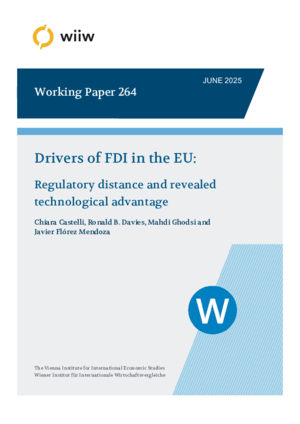Drivers of FDI in the EU: Regulatory distance and revealed technological advantage
Chiara Castelli, Ronald B. Davies, Javier Flórez Mendoza and Mahdi Ghodsi
wiiw Working Paper No. 264, June 2025
45 pages including 10 Tables and 6 Figures
This study examines the interplay between trade policy, in particular non-tariff measures (NTMs), and revealed technological comparative advantage (RTA) at the NUTS 2 level as drivers of foreign direct investment (FDI) over time. Combining data from the Orbis database (Bureau Van Dijk), the NTMs database (WTO I-TIP) and the European Patent Office (EPO PATStat), we construct a comprehensive panel database of European firms owned by foreign-owned EU and non-EU firms. This database includes financial information for both parent companies and their subsidiaries as well as detailed country- and sector-specific trade barriers from the perspective of both the home and host economies. Furthermore, this database allows us to compute tailored RTA variables reflecting firm-specific technological interests proxied by firms’ patent production across technology classes. Using a Poisson pseudo-maximum likelihood (PPML) estimator, our analysis reveals a heterogeneous impact of NTMs and RTAs on FDI investment in the EU regions. Specifically, while increasing the regulatory distance (RD) of technical barriers to trade (TBTs) and sanitary-and-phytosanitary-standard (SPS) measures hampers FDI investment from extra-EU companies, the results on tariffs support the regulatory jumping motive. Furthermore, local technological capabilities significantly support FDI, especially when RTAs reflect the technological interests of the foreign-owned subsidiary, while the effect is reversed when accounting for the innovation portfolio of the parent company.
Keywords: FDI, tariff and non-tariff measures, revealed technological advantage
JEL classification: F23, O24, O34, R58
Countries covered: European Union
Research Areas: International Trade, Competitiveness and FDI
